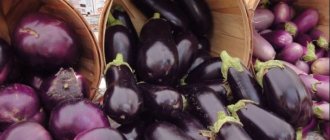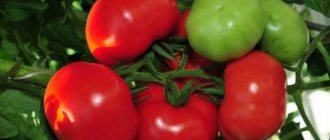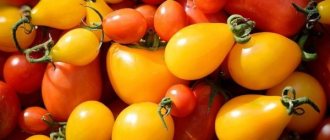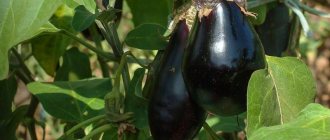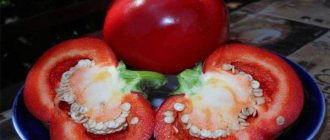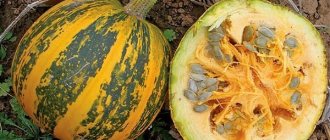From the history of the origin of eggplants
The homeland of the vegetable is Southeast Asia, more specifically, tropical India and Burma. There the plant was observed growing wild. It is believed that eggplant was classified as a cultivated plant in the first millennium BC.
The Greeks in ancient times were convinced that this vegetable could make a person crazy, and therefore called the eggplant the “rabies apple.” Because of this, the plant came to European countries much later.
Initially, eggplants were used for decorative purposes, as the fruits have different shapes, colors, and shiny
After information was received that Indians eat vegetables, they began to be celebrated in South America. The Russians adopted the experience of cultivating eggplants from the Caucasians and residents of Central Asia; this happened in the 18th century. In the southern part of the country, varieties such as Odessa Early and Bulgarian Semi-Long began to be grown.
The first subspecies was sown at the end of the second month of winter, and the second in the twentieth of February. Harvesting took place for the Odessa variety at the end of June, beginning of July. For another - in early August.
The best eggplant varieties 2021 by region for open ground
To get a good harvest, you should adhere to a simple rule - grow only those varieties of vegetable crops that can easily take root in the climate of a certain region. This approach will protect against mistakes, allowing the gardener to collect a maximum of kg of grown product.
The most productive varieties
The list of the best productive varieties that bear maximum fruit includes 10 varieties that were popular in past years among summer residents. Both hybrid, artificially developed varieties, and classic varieties, improved over time from various diseases and the possibility of germination in central Russia, thanks to self-pollination, are relevant.
- Mulatto F1;
- E Star F1;
- Milkman;
- Robin Hood;
- Goliath Dessert;
- Snowball;
- Overseas minke whale;
- Anet F1;
- Eskimo F1;
- Clorinda F1.
New varieties
Every year, breeders offer various varieties of eggplants, characterized by impeccable taste, high yield and increased endurance. However, in order to be confident in the description indicated on the back, it is worth choosing last year’s varieties, tested by gardeners and received favorable reviews.
The list includes hybrids with the conditional addition F1: Tufted family, Eskimo, White Knight, Anet. Speaking about the classic types, we can highlight: Royal caviar, Oriental prince and Finger.
White eggplants, varieties
Just like in fashion, the agricultural company industry does not stand still, offering consumers not only “little blue” but also “white” eggplants, visually similar to zucchini. They can have an elongated, oval or even cylindrical shape, a subtle or pronounced aroma, tender or dense pulp, suitable for preservation.
Among the popular ones for 2021 are:
- Icicle;
- White Knight (F1);
- Swan;
- Snowball;
- Mushroom taste;
- Milkman;
- White Night.
Large varieties
Large fruits can be grown not only in greenhouse conditions, but also in open garden conditions, if the climatic conditions are close to the southern regions, with stable weather that does not change from time to time.
F1:
Tirrenia, Galine, Black Giant, Emerald, Anet.
Classic:
Snowball, Big Lump, Ball-shaped and Sailor.
For Siberia
In a cold region, the most suitable option would be to germinate seeds oriented to the Urals and Siberia. Cold temperatures in summer, dropping by 15-20 degrees at night, are only suitable for frost-resistant breeds that can easily cope with unstable cyclones.
- Purple caftan;
- Northerner;
- Siberian Prince;
- Epic F1;
- Faith;
- Cordate;
- Purple ball.
For the Moscow region, Voronezh and Lipetsk regions
In order to grow early ripening varieties in the middle and central parts of Russia, you should take a closer look at the varieties: Bull's forehead, Robin Hood, Clorinda F1, King of the North F1, Carlson.
Botanical features of the vegetable
Eggplants belong to the nightshade family.
In Russia the plant is grown as an annual.
| ROOT | developed, powerful, goes deep up to one and a half meters |
| STEM | pubescent, rounded, strong, has a purple tint, prone to branching |
| FOLIAGE | simple, large, notched, alternate, similar in shape to oak leaves, pubescent |
Determinate varieties are up to 1 m 20 cm in height. Interminant varieties are up to 300 cm in height. The leaves are located on elongated cuttings. Many varieties have thorns on the foliage and shoots.
Blooms with large, single flowers. In certain subspecies they are collected in 2-3 inflorescences. The larger the flower, the more massive the vegetable will be. The color range of flowers can be purple, lilac or white.
Fruits vary in weight. This directly depends on the variety.
It can be 70 g or 800 g. It comes in the form:
- ball
- keg
- pears
- oval
- cylinder
The consistency of the pulp also varies, from elastic to loose
It tastes sweet or bitter. Color – yellow, green or white.
Eggplants love:
- warm (24-27 degrees)
- light
- moisture (75-80% soil moisture)
Always with a luxurious harvest - productive varieties
Everyone who works on the land wants to see the fruition of their labors in the form of a bountiful harvest. Therefore, varieties that are known to consistently produce a large number of high-quality fruits are very popular. Some of them are particularly popular among Russian gardeners and have many positive reviews. These include without hesitation the Almaz and Alekseevsky varieties already described here earlier. But there are other varieties of eggplants, practically not inferior to them in terms of productivity, included in the State Register.
Black Beauty - this variety of eggplant has an average ripening period and is not inferior to Almaz in terms of productivity. The plant is unpretentious and has excellent disease resistance. At an average height of the bushes - 60-80 cm - numerous fruits weighing up to 200 grams grow, which ripen in 110-145 days. Their tender yellowish flesh is not bitter and contains very few seeds.
The eggplant variety Black Beauty is not inferior in yield to the Almaz variety
The Robin Hood eggplant variety has gained popularity among vegetable growers for its stable yield and extraordinary resistance to negative growing conditions. Its spreading bushes, 70–100 cm in height, produce quite a lot of fruits, which when ripe weigh up to 300 grams. The Robin Hood variety has lilac-colored fruits that are good when pickled or fermented, which distinguishes them from many of their relatives.
Robin Hood eggplant variety is resistant to weather vagaries and consistently productive
Speaking about productive eggplants, one cannot fail to mention the hybrid variety Epic. This hybrid, classic in both appearance and taste, is grown throughout Russia. Powerful Epika bushes, reaching a height of 100 cm, produce fruit within 65 days after planting in the garden. The weight of each eggplant can be up to 230 grams, and the yield from 1 m2 of beds can be 5.8 kg. Epic is resistant to all the most common diseases of plants of this species.
Epic eggplant variety is powerful and disease resistant
Useful properties of eggplant
The vegetable contains a lot of useful substances, especially for the heart.
Here are the elements:
- potassium
- calcium
- magnesium
- gland
- copper
- phosphorus
There are also vitamins B, C, PP, carotene
It is advisable to eat eggplants for people with:
- atherosclerosis
- various heart diseases
- vascular pathologies
- obese
For preventive purposes to prevent colds, anemia, diseases associated with the nervous system, for elderly people to maintain the body in good shape. It is also advisable to include it in a low-calorie diet.
Vegetables will help overcome:
- insomnia
- depression
- Bad mood
They should be eaten after strokes, as the vegetable will help the body recover. Not prohibited for diabetics. Eggplant has regenerating and antibacterial properties. Eggplant infusion removes bile.
They say that if you regularly eat eggplants, it will help you quit smoking, since the vegetable contains nicotinic acid.
Dry peel can lower blood pressure
You need to grind it and eat a teaspoon before meals. The same powder will help strengthen your teeth and gums. To prepare, take salt and ground (to powder) eggplant peel in equal quantities (a teaspoon each) and pour in boiling water.
After cooling, rinse the mouth. To have a positive result and less harm to the gastrointestinal tract, vegetables should be consumed boiled.
Growing conditions and care for eggplants (with video)
Growing eggplants in the photo
In the south, eggplants are called “blue” because traditionally this vegetable is blue-violet in color. It is now that white-, yellow-, red- and almost black-fruited varieties have appeared. They are grown in almost all European countries.
In Russia, eggplants are cultivated in open ground only in the southern regions. Good yields are obtained in temperate climates when cultivated by seedlings in greenhouses.
Eggplant is a heat-demanding crop (more so than tomatoes and peppers). For normal growth and development of plants, a temperature of +20...+30 °C is required. Does not tolerate frost; at a temperature of +8...+10°C, seedlings die within 5-8 days.
One of the conditions for growing eggplants is to ensure sufficient soil moisture, but on waterlogged soils and high air humidity, the crop suffers from diseases. Eggplants need intense sunlight, but prolonged heat has a depressing effect on them.
Light humus soils with a slightly acidic reaction are suitable for growing eggplants in open ground. On cold, heavy, clayey soils, the development and growth of the root system is delayed, and fruiting is sharply weakened. It also reacts negatively to saline soils.
It is also a very light-loving crop. Insufficient lighting leads to various plant diseases, and lack of regular watering leads to spider mite infestation.
Good precursors for eggplant are: beans, peas, cucumber, cabbage, and herbs.
In terms of its demands on external conditions, the eggplant crop is close to pepper. Shoots appear 14-21 days after sowing the seeds. Seeds remain viable for 5 years.
Since eggplants form a large vegetative mass (their height often reaches 1 m or more), their cultivation requires a significant dose of fertilizer. When caring for eggplants while growing the crop, when the fruits begin to swell, each watering is combined with fertilizing with soluble potassium fertilizer.
Due to their slow growth and high heat requirements, eggplants are cultivated mainly by seedlings, and it is best to use potted seedlings.
Seedlings ready for planting should have a well-developed root system, a thick stem 10-12 cm high and 5-7 true leaves.
One of the features of growing eggplants is the impossibility of planting seedlings in open ground without preliminary hardening. This agricultural technique is used for 8-10 days.
For eggplants, it is necessary to allocate areas that are well lit by the sun.
Among the pests, eggplants are inhabited by Colorado potato beetles and, in hot, dry weather, by spider mites. From the first generation of beetles, spray with “Bison” or “Tanrek”. A month before harvesting, plants should be sprayed against mites with Fufanon or Iskra M.
If the number of the second generation Colorado potato beetle is high, use any biological preparation - “Fitoverm”, “Agravertin.” or "Iskra Bio". Biological products also suppress ticks. Spraying with them is repeated 2-3 times with an interval of 5-7 days.
The video “Growing and caring for eggplants” shows all the basic agricultural techniques:
Next, you will find out which varieties of eggplant are grown in seedlings.
Late ripening varieties
These are not in demand in open ground, since they do not have time to ripen before the onset of frost, but they are practiced in the south.
Bull forehead
Bull forehead
- The fruits are large: up to 20 cm long, weighing up to 1000 g.
- The color is violet-brown.
- The pulp is not bitter.
- Ready for use 150 days after planting.
- If the goal is long-term storage, then this variety is perfect.
Mishutka
Mishutka
- This eggplant is valued in cooking due to its high quality.
- You can harvest the fruits after 140-150 days.
- The shape of the vegetable is elongated, pear-shaped, almost black.
- Weight no more than 300 g.
- There is resistance to cold and disease.
Selection of varieties in 2021
To decide on the choice of variety for germination on the site, you should weigh all the positive and negative aspects. For example, the best varieties of eggplants for open ground can be low-growing or tall bushes that require garter. The fruits, like the tops, set after 85-130 days, depending on the speed of ripening of the variety. Appearance - may vary in shape, length and color.
Speaking about taste, we can distinguish both vegetables with a bitter aftertaste and fruits with a sweet and neutral taste. Breeders have tried to find various solutions that will appeal even to people who prefer delicious dishes in their daily diet.
For central Russia in 2021, it is best to choose eggplant varieties that are suitable for open ground (beds) and have the best qualities. Namely such as:
- persistent resistance to diseases and pests;
- varying ripening times;
- bright or, on the contrary, neutral taste;
- even color of the peel, with tints or irregularities;
- the harvest is above average;
- endurance to temperature changes and light frosts.
The best can be called new varieties of hybrids, which stand out with the full measure of their merits. Their only drawback is the impossibility of re-growing from seeds. If you want to save money, it is better to choose classic varieties, with the ability to store and plant seeds from already collected eggplant fruits.
Carpal eggplants
I would like to separately consider vegetables that grow unusually for many. The fruits are arranged in clusters of several pieces. Two such varieties have already been discussed above. These are Balagur and Mantle, but there are several more interesting subspecies.
Samurai
Samurai
- This dark purple eggplant is an early variety.
- Ripens in 95-100 days.
- Fruits weigh no more than 230 g, are resistant to diseases and cold snaps.
- You can actually take up to 6 kg per m2. If we talk about taste characteristics, then the important thing is that there is no bitterness in the pulp.
Prado
Prado
- There are similarities with the variety described above. These are taste, color, early ripening.
- Differs in shape and size.
- The vegetable is similar to a pear, the weight of one fruit is no more than 200 g.
- About 6 kg is also collected per m2.
- It can be grown both in an open garden plot and in greenhouse conditions.
The best varieties of eggplants 2021 for open ground, description + photo
Despite the opinion of many people on city forums, breeders claim that the best varieties of cultivated plants do not exist. Productivity depends not only on the stated data on the back of the package and proper care, but also on the climate of the region. For central Russia, the most suitable options will be self-pollinating fruits. In the Moscow region, Voronezh and Lipetsk regions, Rostov-on-Don and Krasnodar Territory, hybrids of early ripening fruits that have stable immunity to diseases are recommended for germination. And for Siberia - only varieties that can withstand a sudden cold snap.
Plants may differ in taste, size and color. The most important thing is not to experiment too much and use new products in combination with familiar varieties of eggplant that have taken root in the garden in past years.
Low growing varieties
The most convenient for growing are low-growing crops that do not require staking. Such eggplants have a thick, stable standard-type stem and large foliage, reaching a length of no more than 1/2 meter.
Compared to tall eggplants, these absorb fertilizer not into the tops, but into the set fruits, growing in the optimal place - an open bed with additional insulation if necessary.
No. 1 - Black beauty
For a small space in the garden, a miniature variety that is immune to the popular disease “tobacco mosaic” is well suited.
According to the breeders, the black beauty has an unusual shape, reminiscent of a drop of water, although not transparent, but black with a slight blueberry tint. The weight is very massive, more than 250 g. The collected vegetables do not taste bitter at all, and most importantly, they are suitable for preparing any main courses, snacks and even preparations for the winter.
No. 2 – Blue-winged pigeon
A variety that is resistant to cold weather, developed by Siberian breeders, is well suited for Siberia. A cold-resistant breed without bitterness, it has a slightly elongated, yet rounded shape, slightly reminiscent of a pear.
The weight of each fruit exceeds 170 g, and the length is at least 40 cm. Fruiting begins 105-115 days after germination. Harvesting from one sq.m. reaches about 5-7 kg.
A distinctive feature is the dense pulp, without bitterness and emptiness.
No. 3 - Northerner
A universal variety for the Middle Zone, North-West, Urals and Siberia, small eggplants that grow like bunches of grapes on one branch are well suited. To taste - they have tender pulp with a small number of seeds. The weight of the fruit does not exceed 180 g, according to reviews from people involved in farming in the cold region of Russia.
No. 4 – Purple ball
If you want to add some “zest” to your garden, you should take a closer look at an exotic variety that looks like a tomato. The pulp is large, round in shape, and differs from tomatoes only in its dark purple skin with a greenish tint. The inner flesh is creamy, closer to beige in tone. The ovary occurs on each bush. On each branch, from 4 to 7 fruits of identical size are formed at once. With proper care, the pulp is tender, but at the same time dense, without the presence of bitterness.
No. 5 - Japanese dwarf
Like other best eggplant varieties in 2021 for open ground, Japanese dwarf is a collectible species of Novosibirsk selection. Unlike most, it is grown in thickening along with other eggplants. According to gardeners, it is ideal to germinate six fruits per square meter. meter There is no need to step-up the culture. Maintenance is simple and does not require frequent fertilization.
Weight - about 270 g. Size - no more than 20 cm.
Tall varieties
In 2021, the best tall-type eggplants can also be planted in open ground. The most important thing is not to forget to tie them up and plant them, regardless of whether they were planted in central Russia or the Moscow region. A length of one to two meters, without care, is unlikely to give a beginning gardener the expected harvest. But for an experienced summer resident, on the contrary, it will pay off all the waste of time and effort.
No. 1 - White Night
Despite the high growth, the minimum volume of the bush allows you to place eggplants in a small area. Dense planting close to each other allows you to collect unusual white fruits in a volume of 7-8 kg per 1 sq.m.
Just like the outside, the inside of the eggplant remains white. The flavor range is similar to the pulp of zucchini, bitterness is completely absent.
White night in its mature form contains a minimum of calories, and most importantly, it is famous among the people for its healing properties. It is used fresh and cooked for the treatment of cardiovascular diseases and urological problems.
No. 2 - Maria
A more complex variety, characterized by branching and powerful stems. As in other cases, the tops are green, the fruits are covered with purple skin, and when cut, they are soft with a snow-white filling.
Appearance: smooth, classic shape. The weight of the fetus does not exceed 200 g.
It takes approximately 90-98 days from germination to fruit harvest, depending on the region.
No. 3 – Beam family F1
A novelty of past years remains a hybrid variety with an average weight of fruits sprouting on one branch. The early ripening variety is resistant to changeable weather, various diseases and pests.
The variety is distinguished by its high growth and yield, accounting for 9-10 kg per 1 sq. meters.
Color, taste and shape - no special features.
#4 – Salamander
The achievement of Russian breeders was an innovative variety with the beautiful name “Salamander”. For 1 sq. m. with proper care, grows from 8 kg of quality product. The period of ripening from the first shoots depends on the region, but rarely exceeds more than 96 days.
There are no distinctive features. Like any other crop, it has a high yield, a standard, one might even say “traditional” color, no seeds in the pulp and no bitterness, which does not require additional removal in cold water.
No. 5 - spherical
Excellent taste, high ripening and large fruits - this is all about the best variety of eggplant for open ground in the middle zone. The spherical variety, characterized by its weight, good branching and glossy surface, allows the fruits to be used for preparing hot snacks and sandwiches.
Fast ripening varieties
For accelerated growth of eggplants, you should choose only early-ripening varieties that are distinguished by ready ripeness within a few months after the first shoots. If we consider in more detail - 65 days after planting on open ground.
No. 1 - Valentina F1
The collection variety, obtained in Holland, germinates perfectly in Russia. Growing outdoors allows you to get a beautiful and tasty product, regardless of the climatic conditions of the region - whether it is hot or cool, the weather is not stable for growing heat-loving plants, eggplants can easily take root and even bear good fruit.
For 1 sq. m. accounts for 4-5 kg of harvest. From planting in the garden to the full ripening of ripe fruits, no more than 60 days pass.
The appearance and weight are standard and do not differ in bright colors. A distinctive feature is an advantage that sets this hybrid apart from other varieties. Valentina F1 is protected at the gene type level from tobacco mosaic.
No. 2 – Taste of mushrooms
By the name you can understand that eggplants of this variety have a mushroom taste, dense but tender flesh. And although this breed does not have a traditional mushroom aroma, the vegetable can be prepared as an appetizer, salad, main course, and even caviar. Many gardeners even manage to combine “Taste of Mushrooms” for winter preparations, harmonizing the taste with forest mushrooms, saffron milk caps and even boletus mushrooms.
The variety stands out for its medium height, elongated pear-shaped shape and milky pulp. The weight range does not exceed 160 g.
No. 3 - Galina F1
Far from being an early variety, it is famous among summer residents for its excellent germination. Fruiting begins 93-96 days after the first shoots. The color is purple with a black tint. The shape visually resembles a cylinder, reaching 280 g of net weight.
The hybrid easily tolerates heat and hypothermia. If the temperature does not fall below 10-12 degrees Celsius, the ovaries do not fall off the tops, but only stop developing for a while, recovering in ripening when temperature indicators are restored.
No. 4 - Green
Another exotic variety of eggplant, which belongs to the category of the best early-ripening varieties of cultivated plants. It has a delicate taste of noble mushrooms, beautiful glossy green skin and light flesh. The weight of each fruit is substantial and can reach 290 g.
Among the advantages, gardeners who are faced with growing “Greens” note the preservation of taste and lack of bitterness, even after heat treatment and cooking.
The plants are classified as low-growing. The height of each can reach no more than 60-65 cm. After full ripening, the fruits acquire a small, as if cut pear-shaped shape.
No. 5 - Robin Hood
When choosing the best varieties among the earliest ripening ones in 2021, it is worth considering the achievement of the Manul agricultural company, which, under the author’s supervision, developed the productive and ultra-early Robin Hood eggplant. Based on the experience of past years, gardeners leave reviews of this variety as universal, ideal for both the middle zone and the Moscow region and Voronezh region.
It is permissible to plant 4-6 plants per square meter at once.
The shape is slightly pointed. Weight - no more than 290 g.
No. 6 - Early ripening 148
For germination in Siberia and the Urals in open ground, you should choose early-ripening, cold-resistant and without bitterness vegetable crops. Such as “Siberian early ripening 148”. It produces a product that develops special varieties for gardeners, created specifically for the risky farming zone. According to the manufacturer, the variety is unpretentious and resistant to diseases and pests.
The weight of each fruit ranges from 170 to 210 g. The color is bright purple. The shape is pear-shaped, slightly cylindrical.
No. 7 - Ural Express
For the unstable Ural weather, which is absolutely unsuitable for growing heat-loving plants in open ground, the ideal solution would be a variety from the agro series, under the beautiful name “Ural Express”.
Among the advantages of the eggplant variety, one can note: immunity to spider mites and the Colorado potato beetle, dense foliage that protects the fruits from sweltering heat and unstable cold snaps.
The fruits are medium in size, almost black in color. The shape is cylindrical. When cut, the flesh is light, the taste is neutral.
#8 - Epic F1
The achievement of Dutch breeders can be called the Epic hybrid with the letter designation F1. It is not picky about germination in the conditions of the northern and southern regions, as well as central and central Russia.
From one sq. meter, it is possible to collect more than 7 kg of healthy product that is not susceptible to the tobacco mosaic virus. The color of the fruit is dark lilac, close to black. The weight of the product does not exceed the average value.
Video + review:
Features of planting seedlings
Seeds are planted for seedlings in mid-February:
- Before planting, check the seeds for germination:
- Wrap in a damp cloth and wait for the seeds to hatch.
- An easier way: place the seeds in a glass of water and select the sunken seeds.
- Now warm up the suitable seeds using a central heating radiator. Then treat with a growth stimulator.
- Prepare the appropriate soil by purchasing it at a specialty store or preparing it yourself from 5 parts turf soil, 1 part sand and 3 parts rotted compost.
- Plant the seeds immediately in disposable containers, because... eggplants do not like transplanting.
Caring for seedlings consists of watering, fertilizing, hardening:
- Monitor the soil moisture, take it out into fresh air for several hours. Provide illumination for seedlings, because they require long daylight hours.
- Seedlings are planted at the age of 8-10 weeks in soil prepared in the fall. The seedlings should be strong with 5-6 leaves.
- The soil is dug up, manure is added, lime is applied, and high beds are formed using sawdust and grass. Eggplants love light, warm soils with low acidity.
- Planted on the southern sunny side, blocked from the north wind.
Follow crop rotation, change the planting location, do not plant in the same place twice, after nightshades. This leads to illness.
At the end of May, beginning of June, the seedlings are planted in a permanent place. Three plants are planted per square meter.
- Dig a hole on the bayonet of a shovel, pour warm water, carefully move the bush, sprinkle with earth without compacting it. Water young plants every other day.
- Then twice a week with warm water.
- Fertilizers are applied two weeks after transplantation, during the formation of ovaries and harvesting of fruits. As fertilizer, use combined mixtures or a prepared solution of chicken droppings and mullein.
- The bushes are tied to pegs, shaped, leaving 4-5 shoots and 6-8 fruits so that they are not small. Leaves blocking the fruit are cut off.
You will find more information about the secrets of growing eggplants outdoors and in greenhouse conditions on this page.
